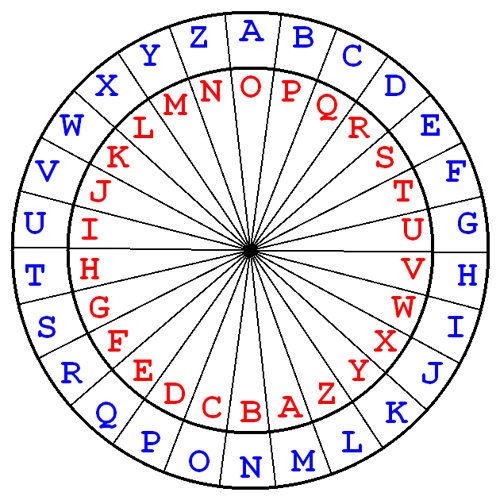Other Vigenère Cipher Devices


Since the Vigenère table is large and not very convenient,
two portable devices were developed to make encryption and decryption easier.
The first device, the cipher disk,
was invented by Leon Battista Alberti (1404--1472).
This cipher disk has two concentric disks,
with the large bottom one fixed and the small top one rotatable.
The 26 English letters are shown along the perimeter of each disk.
One can rotate the top disk to align any letter with the letter
A on the bottom disk.
The plaintext and ciphertext use the letters on the bottom and top disks, respectively.

The use of the cipher disk is very simple. Rotate the top disk so that the keyword letter being used aligns with the letter A on the bottom disk, and the corresponding plaintext and ciphertext letters are on the bottom and top disks, respectively. This alignment procedure is equivalent to shifting the rows down. For example, if two As are aligned together, we are using row A; if B is aligned with A, we are using row B; and if C is aligned with A, we are using row C. Therefore, the cipher disk uses a rotatable disk to replace a large table, and is more convenient.
Consider the 10-th letter E in the plaintext and the corresponding keyword letter O.
MICHIGAN TECHNOLOGICAL UNIVERSITY HOUGHTON HOUGHTONHOUGH TONHOUGNTO TWWNPZOA ASWNUHZBNWWGS NBVCSLYPMM
Rotate the top disk until O aligns with A (see the figure below) and, consequently, the plaintext letter E on the bottom disk aligns with the letter S on the top disk. Therefore, E is encrypted to S.

Conversely, the 10-th ciphertext letter S corresponds to the keyword letter O. Rotate the top disk until O aligns with A, and the ciphertext letter S on the top disk aligns with the letter E on the bottom one. Hence, the decrypted letter of S is E.
Another simple device is usually referred to as the Saint Cyr Slide or just simply slide. The top row of this slide is fixed and has the 26 English letters.

The bottom row can be slided left and right and has two sets of the 26 letters (i.e., repeating the 26 letters twice). Note that the second set only needs 25 letters from A to Y. Why? Its use is identical to the cipher disk with the top fixed portion for the plaintext letters and the bottom movable portion for the ciphertext letter. We just slide the bottom portion so that the keyword letter aligns with the letter A and the top and bottom rows provide the corresponding plaintext and ciphertext letters.
Consider the 5-th letter I in our example. Its corresponding keyword letter is H. Slide the bottom portion so that H aligns with the A of the fixed portion and the plaintext letter I corresponds to the letter P. Therefore, I is encrypted by H to P.

The 11-th ciphertext letter is W and the corresponding keyword letter is U. To decrypt, slide the bottom portion so that U aligns with A of the top portion. The ciphertext letter W in the bottom corresponds to C in the top, and W is decrypted with U to C.



|

|

|